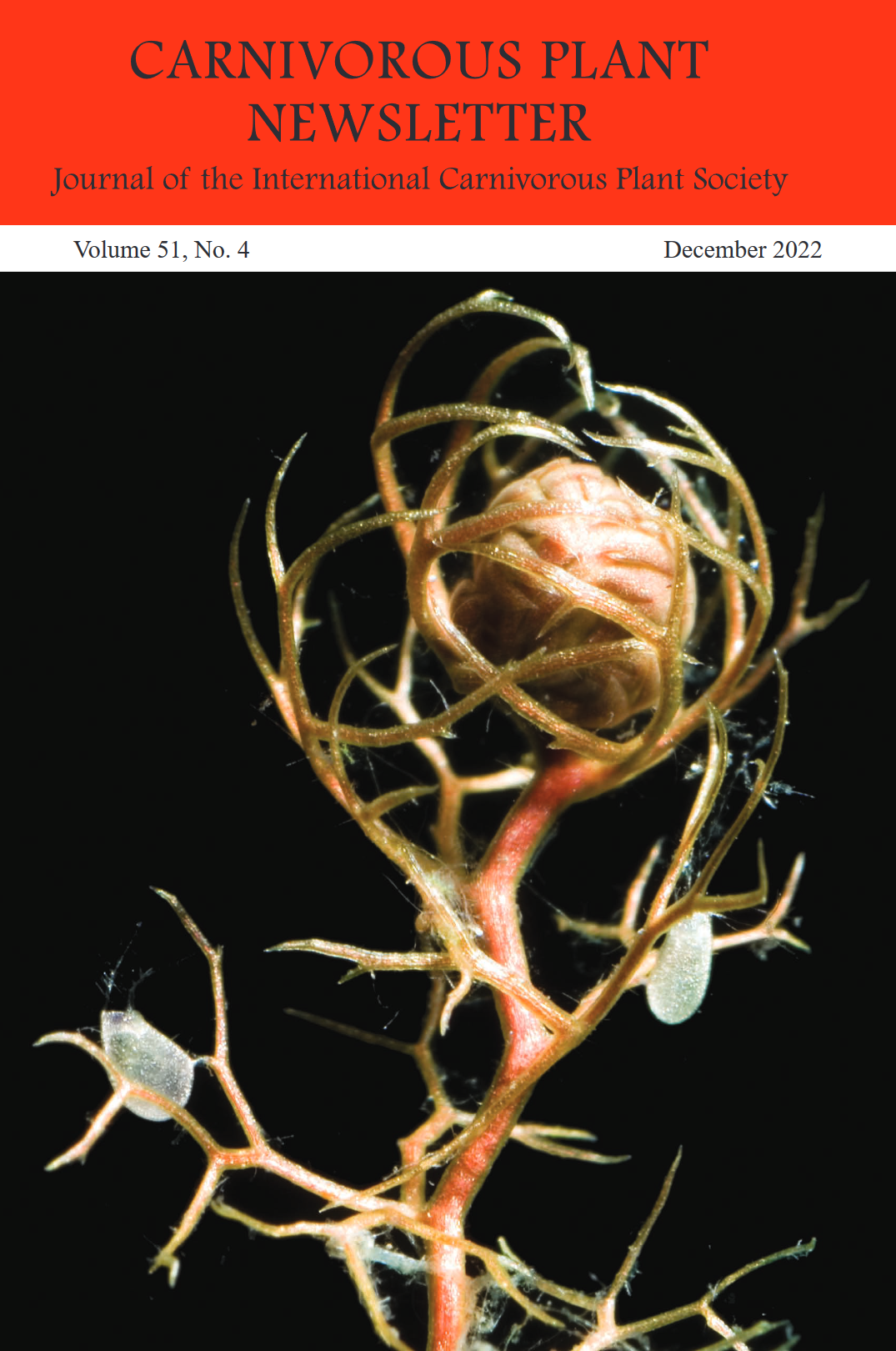|
 Proboscidea and Dicyphini: An example of spontaneous mutualism Proboscidea and Dicyphini: An example of spontaneous mutualism
by a population of predatory bugs inhabiting a sticky plant.
Siegfried R. H. Hartmeyer and Irmgard Hartmeyer • Germany • s.hartmeyer@t-online.de. https://doi.org/10.55360/cpn514.sh212
Keywords: Dicyphus errans, Miridae, mutualism, Proboscidea, Ibicella, Martyniaceae, Byblidaceae, Droseraceae, Roridulaceae, arthropods, Devil’s Claw.
Jetzt verfügbar / now available: Der vollständige Text / Full text (PDF)

Abstract:
A population of the mirid-bug Dicyphus errans (Miridae) a species occurring in Europe, colonized a group of Devil’s Claw (Proboscidea louisianica subsp. fragrans
(Martyniaceae)) native to the USA and cultivated in a garden in
Germany. More than 20 individuals of these predatory bugs have been
found living and moving freely on these sticky plants, feeding on stuck
victims, while garden ants (Lasius
spp. (Hymenoptera)) trying to place aphids for “sugar
farming” became captured together with their “productive
livestock”, as do small flies and bees. The observations on this
spontaneous mutualism between the American Devil’s Claw and a
small mosquito-like European mirid-bug has been recorded on video
(Hartmeyer 2022). This constitutes an additional example for the
adaptation of these ubiquitous predatory bugs to feed on the prey of
sticky plants that would usually capture small-sized insects. The
American Frank Obregon (2017), who found native mirid-bugs on his
cultivated Roridula (Roridulaceae) in California, called the phenomenon assisted carnivory, which fits quite nicely. Proboscidea as well as Roridula
do not produce digestive enzymes, so they cannot benefit directly from
their diverse captured prey. But as soon as predatory bugs colonize the
plants and feed on the sticking prey, their droppings provide a
suitable fertilizer to be absorbed by the stomata of the leaf. A
perfect mutualism. In addition, some historic facts on bug-plant
interaction are provided. |
References:
Anderson, B., and Midgley, J. 2002. It takes two to tango but three is a tangle: mutualists and
cheaters on the carnivorous plant Roridula. Oecologia 132: 369-373.
https://doi.org/10.1007/s00442-002-0998-1
China, W.E. 1953. Two new species of the genus Cyrtopeltis (Hemiptera) associated with sundews
in Western Australia. The Western Australian Naturalist 4(1): 1-8.
China, W.E., and Carvalho, J.C.M. 1951. A new ant-like Miridae from Western Australia
(Hemiptera, Miridae). Annals and Magazine of Natural History 4(39): 221-225.
https://doi.org/10.1080/00222935108654146
Clarke, C. 1997. Nepenthes of Borneo. Natural History Publications (Borneo) Sdn. Bhd.
De Geer, C. 1773. Mémoires pour servir à l’histoire des insectes. Tome troisième. Stockholm: Pierre
Hesselberg, 696 pp.
Ellis, A.G., and Midgley, J.J. 1996. A new plant-animal mutualism involving a plant with sticky
leaves and a resident hemipteran insect. Oecologia 106(4): 478-481.
https://doi.org/10.1007/BF00329705
Hartmeyer, S.R.H. 2022. Video: Teufelsklauen sind Wanzenpflanzen: Proboscidea & Dicyphus / A
Bug-Plant-Mutualism. https://youtu.be/lK4UDim3NMM
Hartmeyer, S.R.H. 2016. Video: Symbiotic bugs living on carnivorous plants in tropical Australia.
https://youtu.be/O-xZOo3Txxk.
Hartmeyer, I., and Hartmeyer, S.R.H. 2005. Byblis filifolia als echte Karnivore rehabilitiert. Das
Taublatt 2005(3): 4-5.
Hartmeyer, S.R.H. 1997. Carnivory in Byblis liniflora revisited II. Carniv. Pl. Newslett. 27(4): 110-
113. https://doi.org/10.55360/cpn274.sh180
Hartmeyer, S.R.H. 1996. Insectivorous plants and entomology. Bulletin of the Australian Carnivorous
Plant Society, Volume 15.
Hartmeyer, S.R.H., and Hartmeyer, I. 1995. Video: Beautiful and Hungry Part 2. Hartmeyer Production.
Heslop-Harrison, Y. 1976. Enzyme secretion and digest uptake in carnivorous plants. In: Sunderland,
N.E., ed. Perspectives in Experimental Biology, vol. 2. Botany. Oxford: Pergamon Press:
463-476.
Lowrie, A. 2014. Carnivorous Plants of Australia Magnum Opus Vol. 1-3. Redfern Natural History
Productions.
Lloyd, F.E. 1934. Is Roridula a carnivorous plant? Canadian Journal of Research 10: 780-786.
https://doi.org/10.1139/cjr34-066
Lloyd, F.E. 1942. The Carnivorous Plants. Chronica Botanica, Waltham.
Martínez, M.A., Duarte, L., Baños, H.L., Rivas, A., and Sánchez, A. 2014. Predatory mirids (Hemiptera:
Miridae) in tomato and tobacco in Cuba. Rev. Protección Veg. 29(3): 204-207.
Obregon. F. 2017. Observations of new Roridula symbiotes. Carniv. Pl. Newslett. 46(2): 74-76.
https://doi.org/10.55360/cpn462.fo111
Penn State New Kensington. 2014. Species pages: assassin bug.
http://www.psu.edu/dept/nkbiology/naturetrail/speciespages/assassin_bug.html, accessed Dec 2016.
184 Carnivorous Plant Newsletter
Rice, B. 2008. Reassessing commensal-enabled carnivory in Proboscidea and Ibicella? Carniv. Pl.
Newslett. 37(2): 15-19. https://doi.org/10.55360/cpn371.br188
Slatner, J. 2019. Dicyphus_ (as “Dichipus”) on _Proboscidea_ (illustration). p. 77 in: Mesojede
rastline: lepotice in zveri. Kranj: Narava d.o.o. za.
Voigt, D., and Gorb, S. 2008. An insect trap as habitat: cohesion-failure mechanism prevents adhesion
of Pameridea roridulae bugs to the sticky surface of the plant Roridula gorgonias. Journal
of Experimental Biology 211 (16): 2647-2657. https://doi.org/10.1242/jeb.019273
|
|
